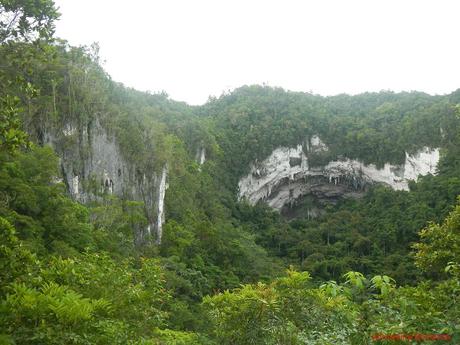
Biggest. Widest. Deepest. Most beautiful. Superlatives in Mother Nature never fail to astound us. They give us a feeling of awe, respect, and reverence. In the Philippines, we are blessed with some of the most wondrous superlatives that capture the world’s imagination. In fact, we are blessed to have one of them right smack in the lush adventure paradise of Calbiga, Samar. Welcome to the monstrous, mysterious, and unearthly Langun Gobingob Cave system.
With an area of 900 square meters spanning over 12 different cave systems, Langun Cobingob Cave is the largest cave system in the Philippines and second largest in Asia. It is also reputed to be the world’s third largest individual karst formation. Many of the sub-systems and dark tunnels that dot the massive cavern remain unexplored.
We had the privilege of exploring this monster, and what a rare privilege it was. That’s because it was the Langun Gobingob Cave that fired up Sir Joni’s interest in the activity. In 1987, Sir Joni, together with an eight-man team of Italian speleologists, first surveyed and explored the cave. But due to insurgencies and rebel infestation in the area, it wasn’t until 2002 when the cave was finally mapped out and documented.
After having a delicious lunch of grilled fish and shrimp, barbecued pork, and ripe mangoes prepared by Sir Joni’s wife Rhine, we were ready for our grand caving adventure. We packed up everything, said goodbye to the family, and went to the bus stop to ride a bus bound for Calbiga.
After a 1-hour ride, we stopped by a popular roadside restaurant called Rutchel’s Native Chicken and Eatery. This establishment has a mutually beneficial relationship with Trexplore and has been a stopover for Sir Joni’s guests.
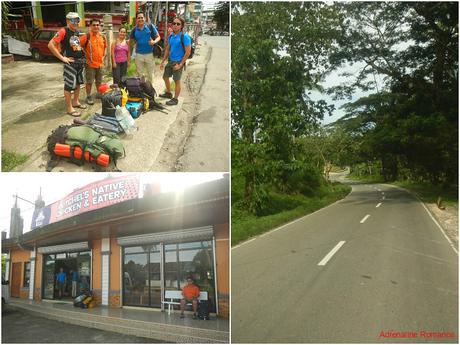
Sir Joni took care of our registration at the town’s tourism office while we took munched on some delicacies. When he came back, he was with some local habal-habal drivers, one of whom tied all our heavy gear on his motorcycle. How could he balance the vehicle with such a heavy load?
We rode towards the uphill barangay of Panayuran, enjoying scenic views while grimacing over the pain of our butts during the relatively rough ride.
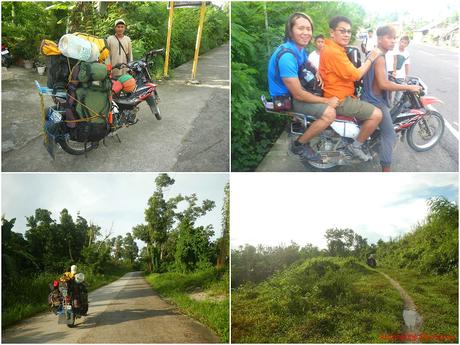
A few minutes later, two young porters came and took the heavy, back-breaking packs. We were definitely ready and excited for this adventure.
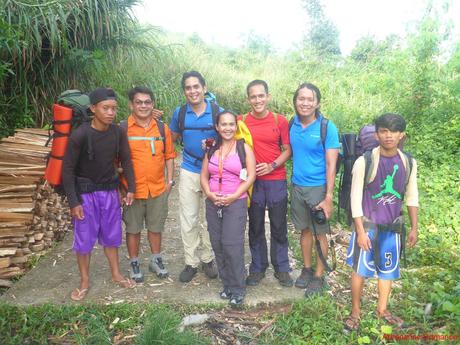
(Photo credit: Joni Abesamis Bonifacio)
We had to earn it the hard way! For an hour, we trekked along exposed farmlands, went inside a thick jungle, and got scratched by sword-sharp and itchy cogon grass to reach an abandoned viewing deck the LGU erected a few years ago. It was a great warm-up!
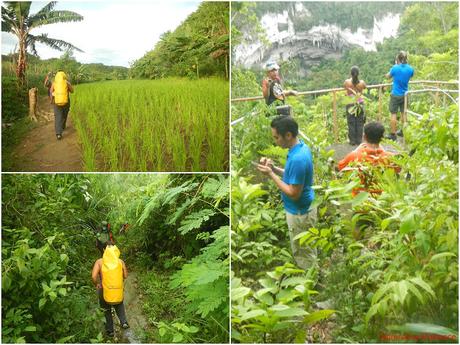
Behold, the massive limestone-cliff entrance of Gobingob Cave. Rising above the thickness of the forest, it so massive that the cavern fills out our field of vision even if it is still half a kilometer away. Its size almost defies description.
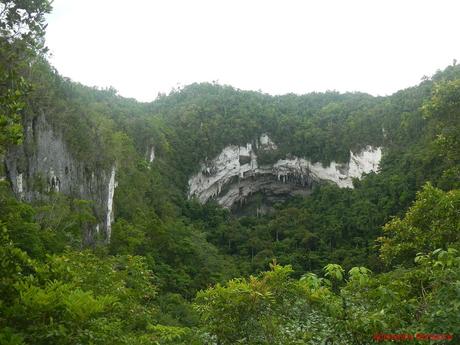
Let’s zoom in at the Gobingob Cave’s cavernous entrance. See those stalactites? Up close, each one is taller than a house! By the looks of it, this immense cliff is hundreds of feet high, rivaling the vastness of the Kiokong White Rock Wall in Bukidnon where we had our vertical bivouac adventure.
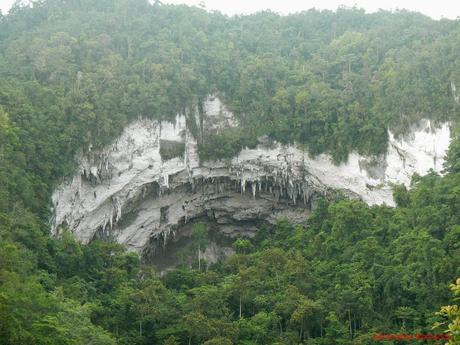
After a 15-minute rest and taking photos of the stunning vista, we started a downhill trek on an abandoned, moss-covered cemented trail to the foot of the cavern itself. Now, you may ask, what is a man-made structure doing in the middle of a lofty jungle? We will get into that later.
“Be careful what you hold on to, and whatever you do, don’t shake the trees,” Sir Joni warned us of swarms of angry wild wasps in the area; they build their hives in some of the light woods along the trail.
“If a swarm attacks you, run!” he quipped.
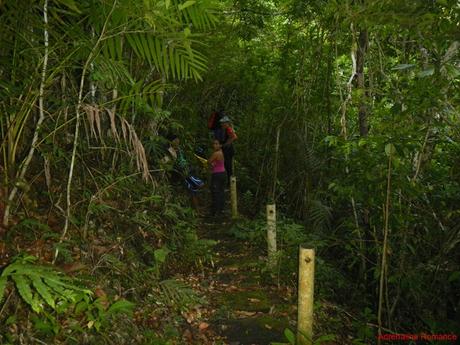
Finally, we arrived at the yawning entrance of Gobingob Cave. Check out how tiny and insignificant we are. And the photo below shows just a tiny part of the cavern.
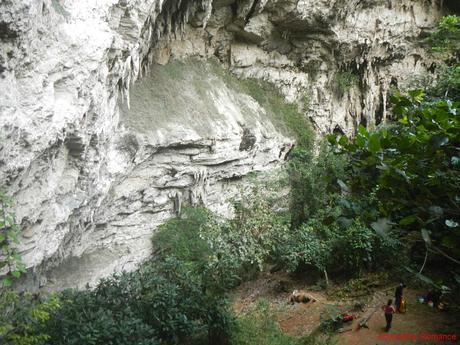
Let’s take a closer look at monster’s maw. Those massive teeth-like stalactites range from the height of an average man to the height of a 3-floor house. These stalactites and the crevices around them are homes to thousands of swallows, swifts, and other forest birds.
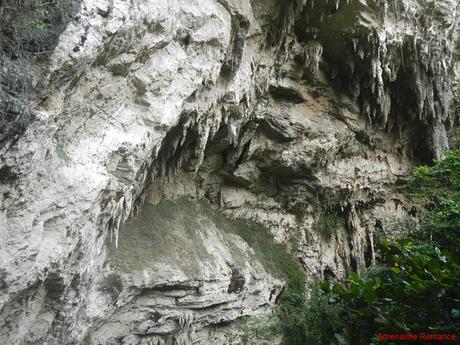
It was already late twilight when we finished equipping ourselves and having a thorough briefing. We started descending down the concrete steps that led to the dark, damp interior of Gobingob Cave.
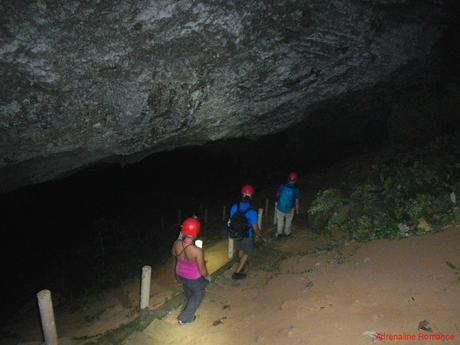
In contrast to the huge facade, our entry was a tiny passage that can accommodate only one person. Dead rock formations indicate that this part of Gobingob Cave has been visited by many people.
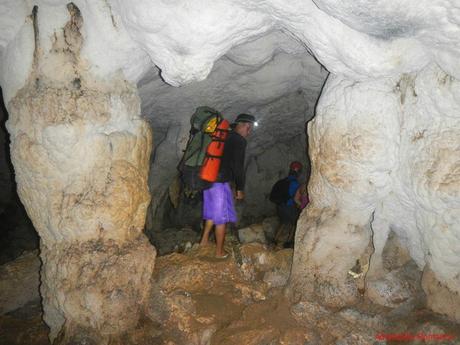
Before entering this great hollowed karst mountain, Sir Joni made us kiss the cave; it’s a traditional custom of luck, reverence, and respect.
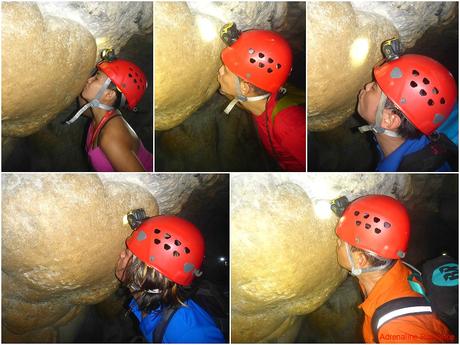
(Photo credit: Joni Abesamis Bonifacio)
Passing by the narrow entrance, the cave opened up to a gigantic chamber that must have a volume of at least a hundred kilometers! We kid you not, that is one enormous natural hollow.
Yet, its grandness did not escape man’s appetite for destruction. See the loose ground that we were walking walking on in the photo below? Those are the sad remains of a small mining operation. In the past, Taiwanese businessmen paid locals to harvest crystalline stalagmites to be used as pendants and home decorations. A section at the front of Gobingob Cave covering an area of a kilometer or two was totally destroyed during the operation.
Fortunately, the cave was granted official protected status before the miners could destroy any more of the precious natural treasure. Today, only iron-pipe markers and the cemented pathway outside the cave remain as a reminder of that dreadful time.
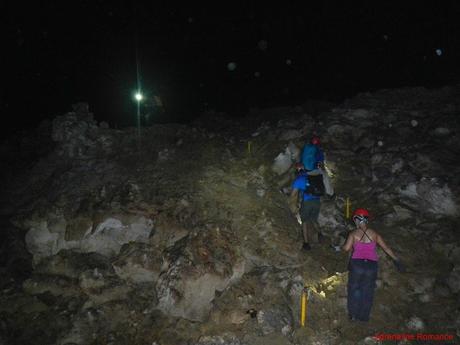
Thankfully, many treasures of the past were left intact in this man-made field of boulders. Check out this crooked stalagmite for instance. It is still white with fresh calcium carbonate.
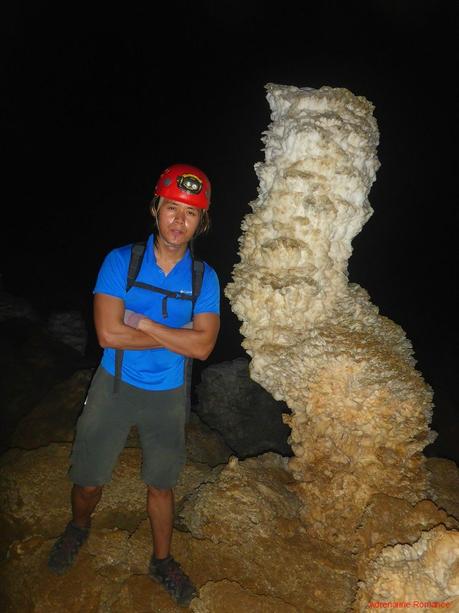
(Photo credit: Joni Abesamis Bonifacio)
And here’s another cool tall one. Do you notice the uneven, rough texture of the stalagmite?
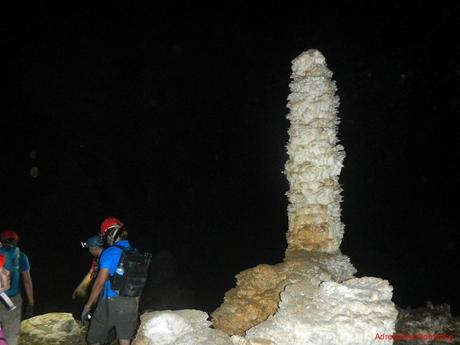
As we moved deeper into the cavern, we saw rocks covered with globular cave popcorn, a kind of small, knobby calcites. With the cave being protective, fresh formations like these popcorn have started to appear.
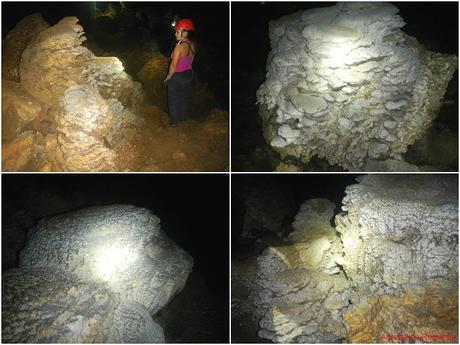
Sir Joni then led us to a vast chamber called the Football Field, a flat area that is as big as its namesake. The ground we walked on is composed of clay-like, compacted mud. It sticks to the soles of our shoes as if the cave wants to hold us to the ground with every step we take.
The stalactite-adorned ceiling soars around 50 feet above our heads. We could see many bats’ luminous eyes staring down at us as they safely observe their visitors from their roosting abodes.
Not visible in the photo is a freshwater pool that is fed from an intricate underground stream. Cavers can refresh themselves in the clear, chilly water and enjoy the sandy bottom. The water here, by the way, is potable.
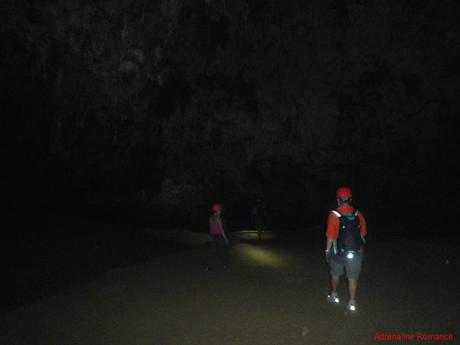
At the end of the Football Field, we set up our camp—yes, we were camping inside a cave! How awesome is that! Sir Joni lit up a butane-powered lamp and lit several small candles around the camp to keep annoying cave crickets at bay. The soft, eerie glow of our light sources highlighted the shadows, lines, and curves of the stalactites above us, emphasizing the beauty of this unworldly scenery.
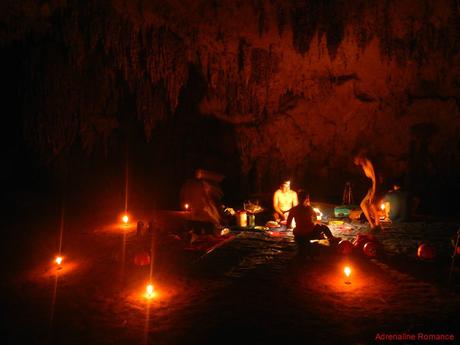
Dinnertime! We had the same tasty viand we had for lunch with the addition of perfectly grilled fish.
If you notice, we were wearing thin, lightweight clothes, and Rio and I even took off our clothes. That’s because the air inside the cave is heavy and very humid; moisture cannot easily evaporate inside the cavern. Indeed, Gobingob cave is so humongous that it has its own climate.
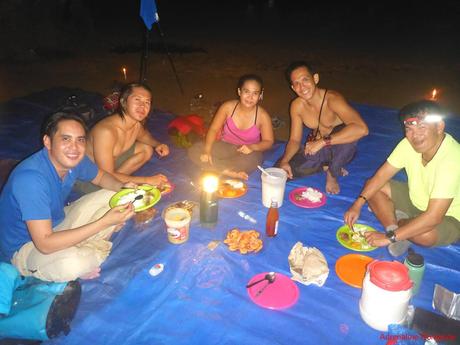
(Photo credit: Joni Abesamis Bonifacio)
After a short rest to let the heavy meal settle in our tummies, it was time to begin the exploration of this vast underground world. Along the way, we marveled at the dogtooth spars and cave popcorn that adorn the stalactites above us and wrinkled flowstones that grew along the wall.
To enter and exit the Football Field, we had to tiptoe on rocks and stalagmite bases that serve as stepping stones across a narrow band of wet, soft mud.
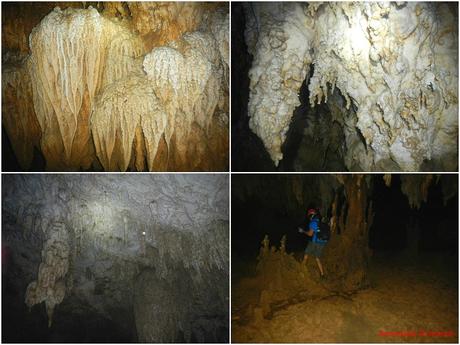
We went out of the Football Field, which was immediately behind The Stage, one of the attractions in side Gobingob Cave.
The Stage is an ancient herculean flowstone that differs from the rest of the cave’s rock formations. As its name implies, the formation looks like a theatrical stage with a very tall backdrop. This was formed after eons of calcium carbonate accumulation.
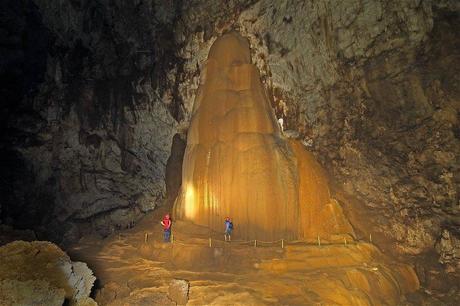
(Photo credit: Edgar Allan Zeta Yap)
Millions upon millions of quartz crystals in The Stage glitters with playful delight as we shone our lights on the structure. The crystals can be easily scraped off the surface, so care must be taken not to touch the rock formation.
Can you imagine if the mining operation reached here before the cave was granted with a “protected” status?
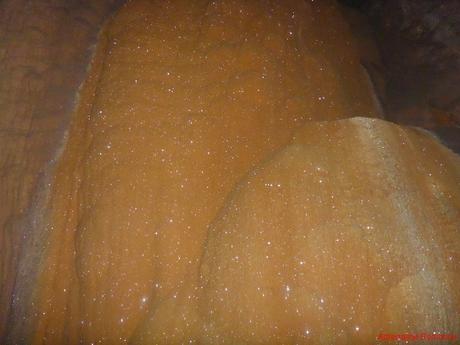
(Photo credit: Joni Abesamis Bonifacio)
Shallow natural pools make up the floor around The Stage. There was probably water here before, but some natural even must have diverted the flow somewhere. The pools are similar to those in Lobo Cave in Jiabong.

Looking vaguely like gargoyles of some Gothic church, bizarre rock formations stick out of the cave’s walls like silent guardians of what lies ahead.
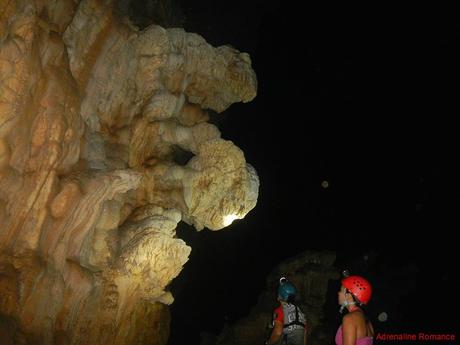
As we moved farther from The Stage, the dead boulders made way for crystalline formations. These massive pedestals form a gate to the start of our adventure for the evening.
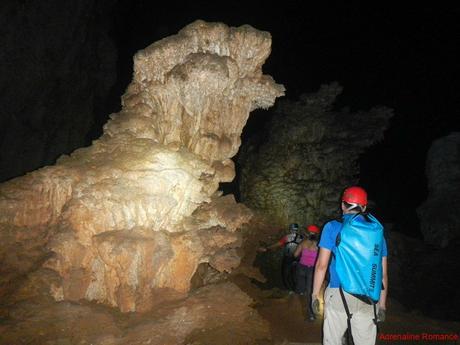
Now, we know this borders on impossibility, but in Gobingob Cave, we were speechless with disbelief. That’s because as soon as we passed the twin pedestals, we started a non-stop ascent up a slope that is made of loose rocks. Believe it or not, we were actually climbing a mountain deep within a cave! It’s like a climb under a moonless night.
An entire mountain inside a cave—-now that is not something you can see everyday, is it? We could not see the ceiling; it is so high that the beams from our headlamps cannot reach it.
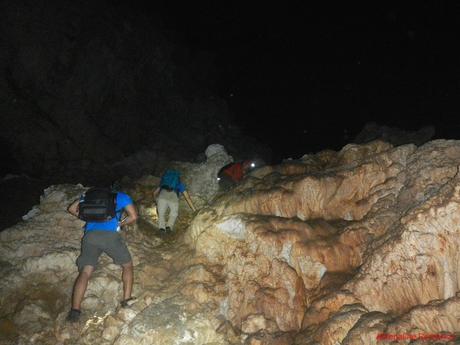
As we moved up, the ground became increasingly white with untouched, crystallized calcium carbonate. It appears similar to snow except that this formation is pure crystal.
It became difficult to find brown, dead rocks where we can safely step on. We don’t want to damage or destroy such amazing creations by carelessly stepping on them.
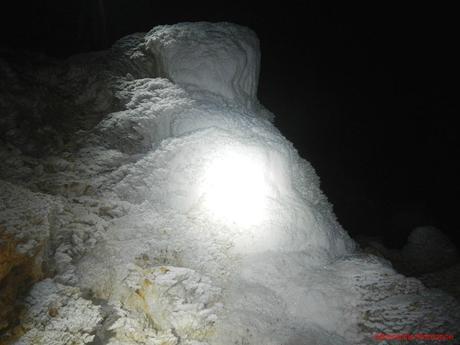
Check out this large wall of crystalline formation! It looks like a wall of hardened cake icing. No, we didn’t touch it.
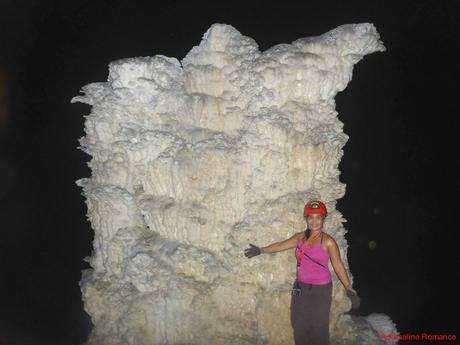
As we moved up the massive underground mountain, we had to stay clear from the walls because there were fragile helictites, dogtooth spurs, popcorn, and frostworks all around us. A single brush can irrevocably damage or wrench them away from the wall.
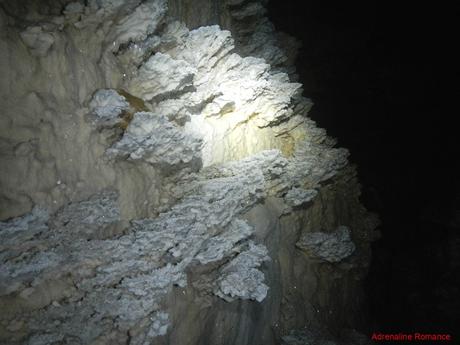
It is quite obvious that cavers barely venture here. The beautiful formations all around us are virginal, and we had a difficult time maneuvering ourselves as we ascended the underground mountain.
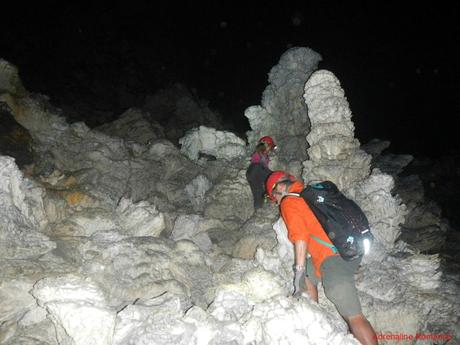
We don’t know how we managed to climb this amazing structure without damaging these delicate, formations that look like they’re covered with snow.
After a while, our teammate Luis theorized why there is a mountain here. Millions of years ago, a cataclysmic event shook the interior of Gobingob Cave, resulting a titanic cave-in. The remains of the cave-in formed the mountain we were standing on.
If so, then Gobingob Cave is the titanic remaining shell of a once solid mountain!
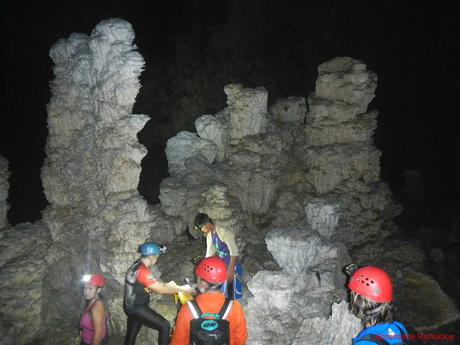
Some of the individual rock formations are so big that they almost defy definition. Check out this wall that has some sort of a window. How in the name of all that is strange was this formed?
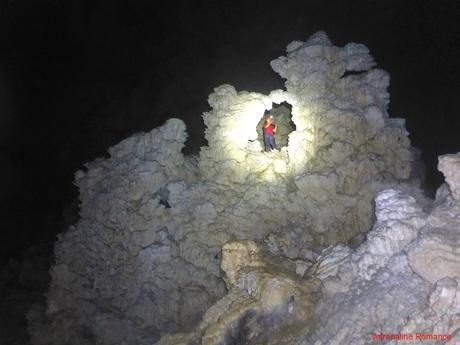
(Photo credit: Joni Abesamis Bonifacio)
While Ed and Sir Joni took photos of me from below for their use, I took a close-up photo of the rock feature closes to me. Those spiky formations are helictites, while the globular ones are cave popcorn. Due to the extreme humidity inside the cave, the formations are perpetually covered with a thin film of moisture.
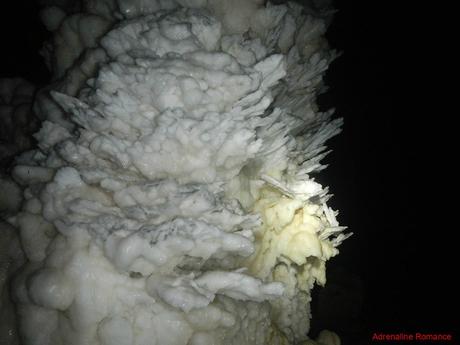
From where I stood, I could make out an ominous structure several hundred meters away. That is the dark, menacing opening of another cave system! Judging from its size, the opening can easily fit a medium-sized church!
Sir Joni later told me that going there entails another five hours of scrambling over treacherous rocks. It leads to a chamber called The Dead End, which consists of beautiful rock formations.

Just to give you an idea of just how tall these crystalline stalagmites are, check out the photo below. Can you see how tiny we are compared to these gorgeous rock formations?
Also, you would notice huge slabs of rock at the left side of the photo below. These are the remnants of a cave-in. In time, they will be covered with calcium carbonate dripping from the ceiling high above us.
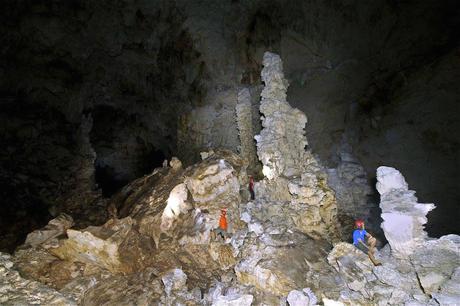
(Photo credit: Edgar Allan Zeta Yap)
Here’s a close-up of one of the tall stalagmites. Check out the strange growths on the surface. These helictites have been slowly carved by one of the weakest natural forces of all—dripping water.
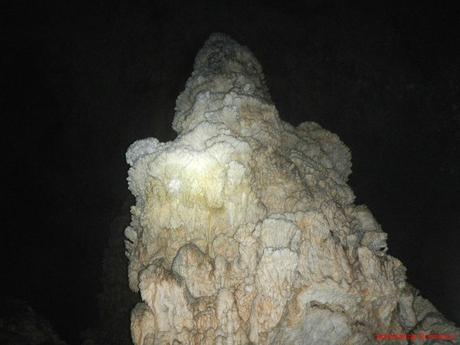
In the distance, we could make out two towering helictite-covered stalagmite. The tall one is as tall as a 5 to 7-storey building!
At last, we reached a point where we could barely make out the ceiling, which actually forms a protective dome over the underground mountain. We were approaching the side of that dome.
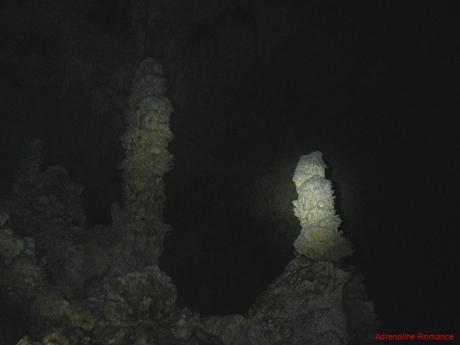
This massive, gnarly column marks the summit of the mountain, which is pressed against one side of the dome. The column, which connects to the domed ceiling, easily rivals The Candle, one of the tallest and largest stalagmites in the Puerto Princesa Underground River.
We have reached the top of the mountain, but we could not see the top of the dome, which is still way above us!
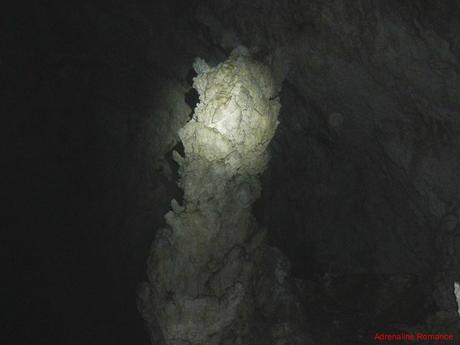
At this point, Sir Joni asked us if we would want to proceed to the Dead End, which is still 5 hours away. Nah, we were a bit tired. Hehehe! So, we decided to head back to the camp in The Football Field.
Sir Joni decided to take to a slightly different route so we could see more magnificent rock formations—as if the ones we’ve seen are not jaw-dropping gorgeous enough.
We skirted a steep, slope dotted with loose rocks. Be careful or you’ll roll down somewhere…
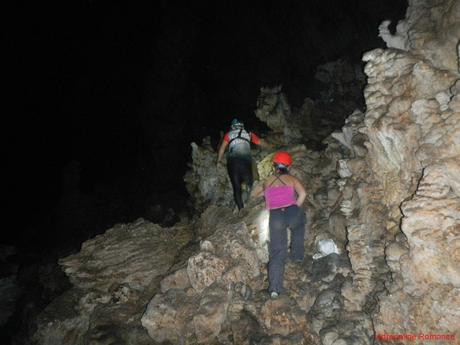
True to our guide’s word, there were even stranger rock formations that differ from the monotonous white, rough stalagmites, walls, and pillars we saw around the mountain.
Check that out; there were rock formations that look like hamburger buns, sugar-crusted ensaymadas, frost-covered balls, and icy spikes. Wow!
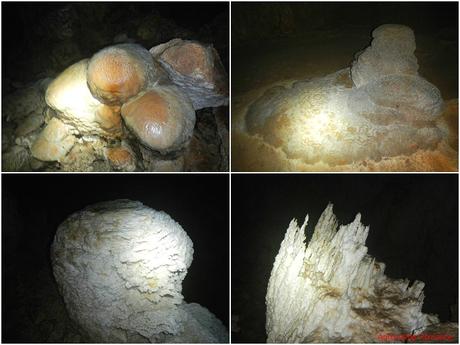
Look at that gigantic, conical spire! It’s like a frost-covered Christmas tree that typically acts as a centerpiece in malls during Christmas season. Would you want to spend your Christmas eve under this spire?
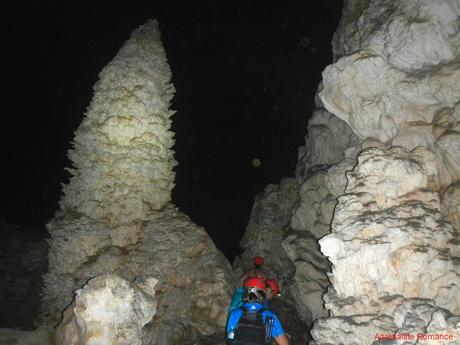
See those flesh-colored petal-like formations on the wall? Those are speleogens, and they are very different from speleothems. Rather than secondary deposits, these formations are created by erosion and the removal of bedrock.
The gentle and sensuous curves made us wonder how Mother Nature carved these formations. Just imagine the endless variations of wind force, dripping patterns, water flows, and other factors that ultimately created these natural works of art.
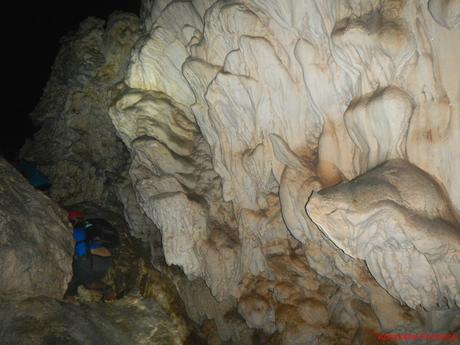
Everything here glitters! Those are millions of gypsum crystals embedded in speloegens.
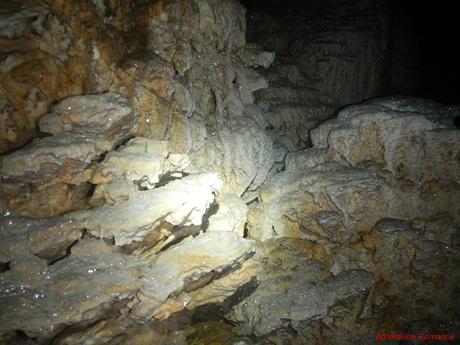
As we descended the mountain, the ground became bouldery, brown, and splotched with mud. Our descent was faster and easier considering that we didn’t have to worry about holding or stepping on delicate cave formations.
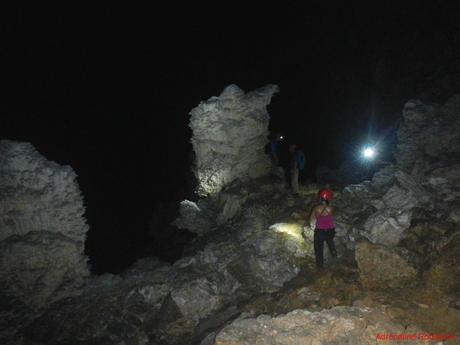
A quarter before midnight, we were back at our small camp in the Football Field where we congratulated each other for an incredible adventure. After washing off the sweat from our bodies, we bid each other goodnight and tried to sleep.
We tried to let Mr. Sandman overtake us, but sleep was difficult for everyone except for Sir Joni and the porter. First, although it was comfortable cool inside the cave, the moist air made lying inside a sleeping bag clammy and uncomfortable.
Then sleep without the sleeping bag, right? Easy for you to say because that would make way for the second problem—curious cave crickets who want to be bed mates with us! The little guys kept crawling on our bodies. Often, they tickle us with their antennas, trying to determine what we are.
Finally, the sounds of water dripping from stalactites to the ground or to the nearby pool were amplified a thousand times in this lofty chamber. The sounds were anything but gentle pitter-patters. They sound like loud bronze gongs. And sometimes, the drips sound like children talking and laughing in the distance as if from a long, large hall! We kid you not!
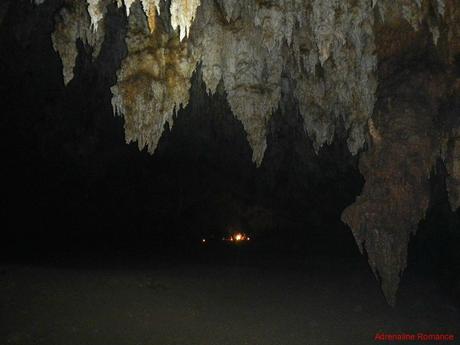
Exploring Gobingob Cave was one of the most astounding adventures we had. Not only did we lay eyes on some of the most spectacular rock formations we’ve ever seen, but we also realized that what we think are impossibilities are often possibilities with Mother Nature. A mountain beneath another mountain is simply an
That is the same with our personal lives. Perhaps, by understanding how persistent she is, we will realize that what we think are impossible for us to accomplished can actually be achieved.
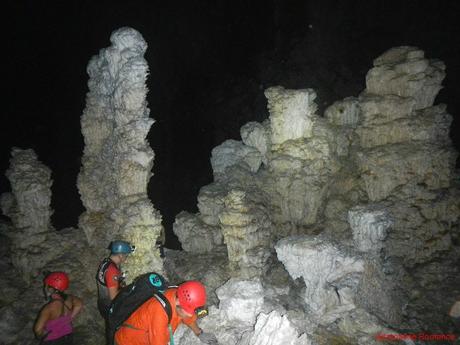
Will we make it out? Watch out for Part 2 of this adventure as we exit through another giant cave. Itineraries, budgets, and other tips will be posted in Part 2 as well.

